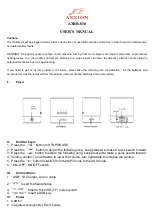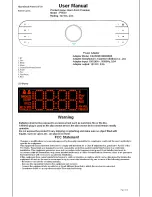
A sound wave approaching the eardrum from your chosen speaker location is shaped by
interactions with the size and shape of your head, torso, and outer ear, resulting in the HRTF.
More specifically, the HRTF is the ratio between the sound pressures of the wave at the eardrum,
as compared to the sound pressure that would exist at the center of the head if the head were
removed. In general, the sound arriving at the ear further from the source is attenuated and
delayed relative to the sound arriving at the ear closer to the source. This generates an interaural
intensity difference (IID) and an interaural time delay (ITD). As a sound approaches the head, the
ratio of distances from the speaker location to the near and far ears increases, and the effects of
head-shadowing are amplified, causing the IID to increase. The spectral shaping caused by the
head and the shape of the outer ear may also change. The ITD, which results from the absolute
difference in path length from the source to the ears, remains approximately constant as distance
decreases. From this we learn:
• ITD is the dominant factor for frequencies below about 500 Hz;
• A combination of ITD and IID are dominant for frequencies between approximately 500 Hz and
2,000 Hz; and
• IID, in concert with HRTF, are dominant above about 2,000 Hz.
These are generalizations, and are subject to the size and shape of one’s head and torso, and size
and shape of the outer ear (the folds and ridges of the ear), but in general, the above is a good
guideline for establishing ITD, IID and HRTF thresholds for the human auditory system.
Because the Legatia Pro midrange’s ability to play into the sub-400 Hz range, an effect clearly
dominated by ITD, up to and including frequencies exceeding 6,000 Hz, an effect clearly
dominated by IID and HRTF, placement of this driver is extremely important. The driver should be
placed as far forward as possible in the vehicle to optimize ITD. Lateral (forward to back) placement
is much more important than horizontal placement (up and down). This is because of the brain’s
ability to process sounds such as spectral envelope cues, and use a phenomenon known as the
“precedence effect”; the brain can be easily “fooled” into thinking a sound stage is high with kick
panel or floor-mounted speakers (a word to the wise: the best place to put a set of speakers is not
always “up high”, as most vehicles do not offer an amicable location in the dashboard or a-pillars for
good image placement for both seated passengers, especially in the critical frequencies sub-500
Hz). In addition to the time equalized placement of the drivers, the end-user must also consider
that above approximately 2,000 Hz, intensity plays a key role in good sound staging and imaging.
Therefore, the Legatia Pro midrange’s should be placed in an area where intensity differences can
be equalized, either mechanically or electronically, to ensure good imaging and sound staging.
The lesson to be learned is that, like Lesson Two, the Legatia Pro midrange should be placed as far
forward from your listening position as possible, and every effort should be made to optimize time
and intensity domain characteristics of the installation.
Lesson Two: Equalization of Pathlength Differences (Continued)
In scenario “a”, we show the installation of the Legatia Pro midrange in the dashboard or high in a
door panel. As you can see from the diagram, the PLD’s between the left and right speakers are
large, due to the proximity of the listener to the near-side speaker. While the mounting of primary
drivers in the dashboard or a-pillars has become increasingly popular, this configuration will
undoubtedly require both time and intensity domain equalization in most vehicles to ensure a
good, focused center image, properly located in the center of the vehicle for
one seated position
.
There are, however, some rare exceptions, and you may actually find that the dashboard locations
provide the best equalized PLD of the available mounting locations; this is very rare though – in
our experience, less than one percent of vehicles on the market today have optimized dashboard
speaker locations for the midbass drivers.
In scenario “b”, a typical door installation location is shown, and in many vehicles represents a
good improvement in PLD’s from the dashboard, high in the door panel, and a-pillar location
identified in scenario “a.” The door speaker installation scenario is the one detailed in the basic
installation section at the beginning of this manual, and in most vehicles represents a satisfactory
location to mount speakers; not ideal but satisfactory. The door speaker installation scenario will
likely also require some amount of time and intensity equalization to ensure a centered image in
most vehicles; this can be as simple as adjusting the balance control on your source unit, to more
advanced ways of digital time and intensity manipulation.
The third and final potential mounting location as shown in this diagram (scenario “c”) represents
a kick panel installation, where the midbass are placed far forward in the A-frame cavity of the
kick panels, present in most vehicles. The kick panels are the small panel next to the throttle and
brake pedals, down by your feet. While it is not immediately obvious looking at a two-dimensional
drawing, in many cases the kick panel location affords the best equalization of pathlength
differences for most vehicles. And the reason why this is a good choice for most vehicles is defined
in the second full paragraph of Lesson Three, below.
The lesson to be learned here is that by taking a few moments to evaluate the potential mounting
locations in your vehicle, in a very short period of time, you will be able to find the best location for
your Legatia Pro midrange by determining the location with the smallest PLD.
Lesson Three: The Effect of HRTF, ITD, and IID
Head-related transfer function (HRTF), interaural intensity differences (IID), and interaural time
delay (ITD) all play a key role in the optimum placement location for the Legatia Pro component
speakers.
.
© Hybrid Audio Technologies • Cumming, GA • 770.888.8200
© Hybrid Audio Technologies • Cumming, GA • 770.888.8200
38
39







































